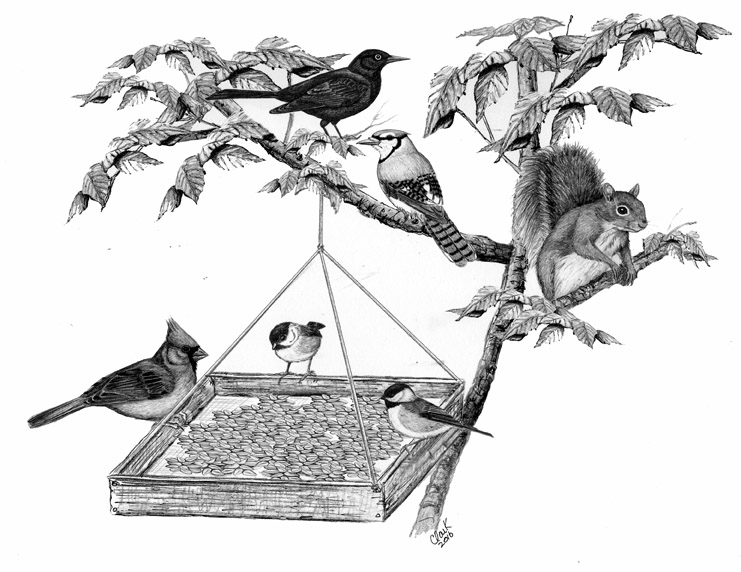
Dear Bird Folks,
I was in your shop the other day and noticed an odd sign that was attached to a barrel of safflower seed. The sign read: “Safflower should not be mixed with any other seeds.” Is there a reason for not mixing safflower or are you just being silly?
– Pam, Sandisfield, MA
It’s real, Pam,
Oh sure, I might occasionally take a shot at society’s quirks or at someone’s long held beliefs. Heck, I might even tease somebody’s child, or worse, insult one of their pets. But there is one line I will never cross and that’s the seed line. Birdseed is not to be made sport of. Birdseed is what keeps both the birds and me alive. The sign you read is real. You should never mix safflower seed with any other seed. If you ever do, I’ll find out about it and will come looking for you in Sandisfield…as soon as I figure out where it is.
Anyone who reads this column knows that I’m not a big fan of mixing birdseed. When birds land on a flower they are after only one thing, the unique seed that a particular flower produces. They are not looking for variety. Humans may like to sit down to a plate of assorted vegetables, pasta and meat (or preferably, a meat substitute), but feeder birds typically focus on one seed (usually sunflower seed) and anything else just gets in their way. The same theory applies to safflower seed; except unlike sunflower, safflower is not the birds’ favorite food. This begs the question: If safflower isn’t a favorite, why would anyone even buy it? People use safflower because some species of birds will eat it, while others often won’t. It’s the food of choice for those folks who like to control which birds come to their yards. In other words, safflower is a bird bigot’s dream.
Black-capped Chickadees, House Finches and those much adored Northern Cardinals readily eat safflower. On the other hand, jays, grackles, crows and even gray squirrels tend to ignore it.* A tray filled with safflower seed is likely to attract hungry cardinals and chickadees, while not appeal to grackles and jays. But if you add some other kind of seed onto the tray, the jays and grackles will instantly come for the added seed and suddenly you have defeated the only reason for buying the more expensive safflower in the first place.
*In the above statement I said, jays, grackles, etc. “tend” not to eat safflower. I didn’t say they never would or made any kind of guarantee. So, if you try safflower and aren’t happy with your results, don’t call your attorney or come complaining to me or I might insult one of your pets…or one your attorney’s pets.
While we are on the topic of birdseed, it is time for my annual warning about meal moths. Regardless of how it is packaged, there’s a good chance that meal moth eggs are already in your birdseed when you buy it in the store. Given enough time these eggs will hatch, especially in hot weather. People who have stopped feeding for the summer may discover that last spring’s seeds are now clumpy, webby, wormy and filled with tiny moths. Or, folks who bought extra seed in July because it was on sale or they wanted to avoid the summer traffic may also discover that their two-month-old seed is now a little funky. Another mistake folks make is that they rarely wash out their seed storage barrels. Remnants of old seed are meal moth heaven. It’s important to note that these moths aren’t harmful to you or to the birds, but the clumps will clog your feeders and freak out your company. Also, if the moths get into your kitchen, you may end up with webby crackers, rice or wheat germ. Until the weather turns cooler (if that ever happens) my advice is to only buy the amount of seed you can use in a few weeks. And if it’s possible, store your seed in your garage or shed and away from your kitchen, or your wheat germ could end up being grosser than it already is.
Thistle seed (aka, niger) presents a different problem. Because thistle is sterilized with heat before being packaged, it is not prone to meal moths. That’s a good thing. However, the high heat shortens the seed’s shelf life. Consequently, thistle will dry out and become unappealing if it is stored for too long. How long is “too long”? I don’t really know, but many of my customers who go away for the winter, discover that very few finches are interested in their feeders when they return in the spring. They are surprised when I tell them that thistle doesn’t stay fresh forever. (They confuse thistle with Twinkies.) Again, my advice is to only buy the amount of seed you can use in a few weeks. And if you do go away for the winter and still have some seed left over, give it to your friends or neighbors to use. Ordinarily, I abhor the thought of giving birdseed away for free, but I’ll make an exception if it saves me from explaining my thistle theory yet again. That explanation is even drier than old thistle.
The sign we posted about not mixing safflower seed is real, Pam, but it’s only meant to prevent folks from combining other seeds that will cause safflower to lose its desired effect. Remember, safflower is only a seed that some birds don’t like, it is not a repellant like mothballs, DEET or wheat germ.